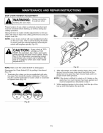
Fig. 11
LIMBING
Limbing a tree is the process of removing the branches
from a fallen tree. Do not remove supporting limbs (A) until
after the log is bucked (cut) into lengths (Fig. 12).
Branches under tension should be cut from the bottom up
to avoid binding the chain saw.
Fig. 12
aever cut tree limbs
while standing on a
BUCKING
Bucking is cutting a fallen log into lengths. Make sure you
have a good footing and stand uphill of the log when cut-
ting on sloping ground. If possible, the log should be sup-
ported so that the end to be cut off is not resting on the
ground. If the log is supported at both ends and you must
cut in the middle, make a downward cut halfway through
the log and then make the undercut. This will prevent the
log from pinching the bar and chain. Be careful that the
chain does not cut into the ground when bucking as this
causes rapid dulling of the chain.
When bucking on a slope, always stand on the uphill side.
1. Log supported along entire length: Cut from top (over-
buck), being careful to avoid cutting into the ground
(Fig. 13).
2. Log supported on one (1) end: First, cut from bottom
(underbuck) 1/3 diameter of log to avoid splintering.
Second, cut from above (overbuck) to meet first cut
and avoid pinching (Fig. 14).
3. Log supported on both ends: First, overbuck 1/3 diame-
ter of log to avoid splintering. Second, underbuck to
meet first cut and avoid pinching (Fig. 15).
NOTE: The best way to hold a log while bucking is to use
a sawhorse. When this is not possible, the log
should be raised and supported by the limb
stumps or by using supporting logs. Be sure the
log being cut is securely supported.
Fig. 14
Fig. 15
BUCKING USING A SAWHORSE
For personal safety and ease of cutting, the correct posi-
tion for vertical bucking is essential (Fig. 16).
A. Hold the saw firmly with both hands and keep the saw
to the right of your body while cutting.
B. Keep the left arm as straight as possible.
C. Keep weight on both feet.
ooWhile the saw is cut- I
vnvmm'_r mI. ting, be sure the chain I
and bar are being properly lubricated. I
Fig. 16
Fig. 13 12


















